2018 MITSUBISHI OUTLANDER III towing capacity
[x] Cancel search: towing capacityPage 84 of 441
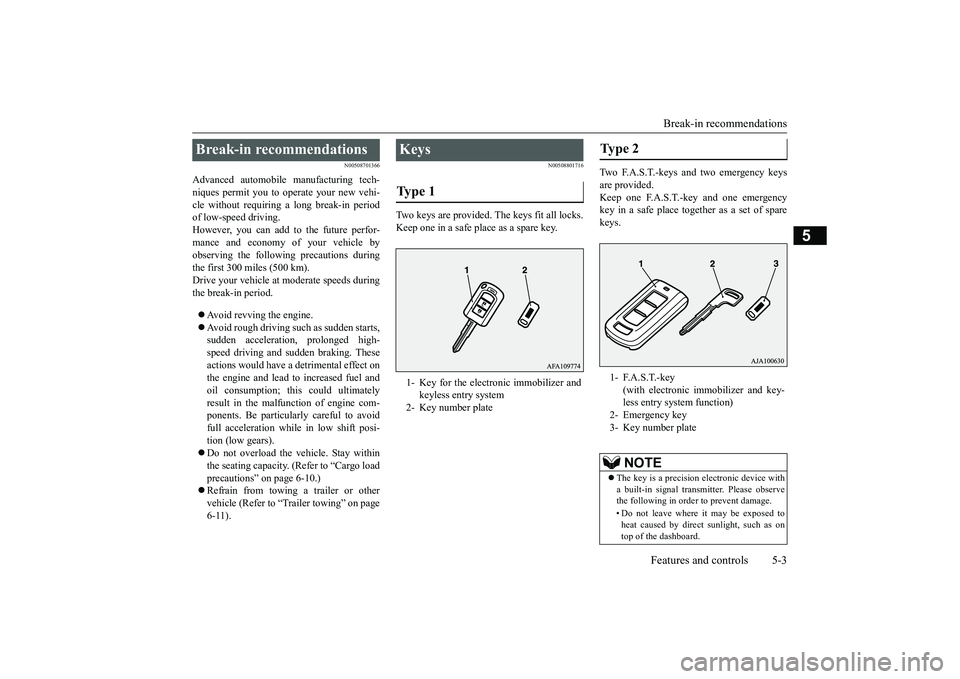
Break-in recommendations
Features and controls 5-3
5
N00508701366
Advanced automobile
manufacturing tech-
niques permit you to operate your new vehi-cle without requiring a long break-in periodof low-speed driving.However, you can add to the future perfor-mance and economy of your vehicle byobserving the following precautions duringthe first 300 miles (500 km).Drive your vehicle at m
oderate speeds during
the break-in period.Avoid revving the engine.Avoid rough driving such as sudden starts,sudden accelerati
on, prolonged high-
speed driving and sudden braking. Theseactions would have a detrimental effect onthe engine and lead to increased fuel andoil consumption; th
is could ultimately
result in the malfunction of engine com-ponents. Be particularly careful to avoidfull acceleration while in low shift posi-tion (low gears).Do not overload the vehicle. Stay withinthe seating capacity. (Refer to “Cargo loadprecautions” on page 6-10.)Refrain from towing a trailer or othervehicle (Refer to “T
railer towing” on page
6-11).
N00508801716
Two keys are provided. The keys fit all locks.Keep one in a safe place as a spare key.
Two F.A.S.T.-keys and two emergency keysare provided.Keep one F.A.S.T.-key and one emergencykey in a safe pl
ace together as a set of spare
keys.
Break-in recommendations
Keys Ty p e 1 1- Key for the electronic immobilizer and
keyless entry system
2- Key number plate
Type 2 1- F.A.S.T.-key
(with electronic im
mobilizer and key-
less entry system function)
3- Key number plate
NOTE
The key is a precision
electronic device with
a built-in signal transm
itter. Please observe
the following in order to prevent damage.• Do not leave where it may be exposed toheat caused by direct
sunlight, such as on
top of the dashboard.
BK0249100US.book 3 ページ 2017年5月10日 水曜日 午前8時49分
Page 173 of 441
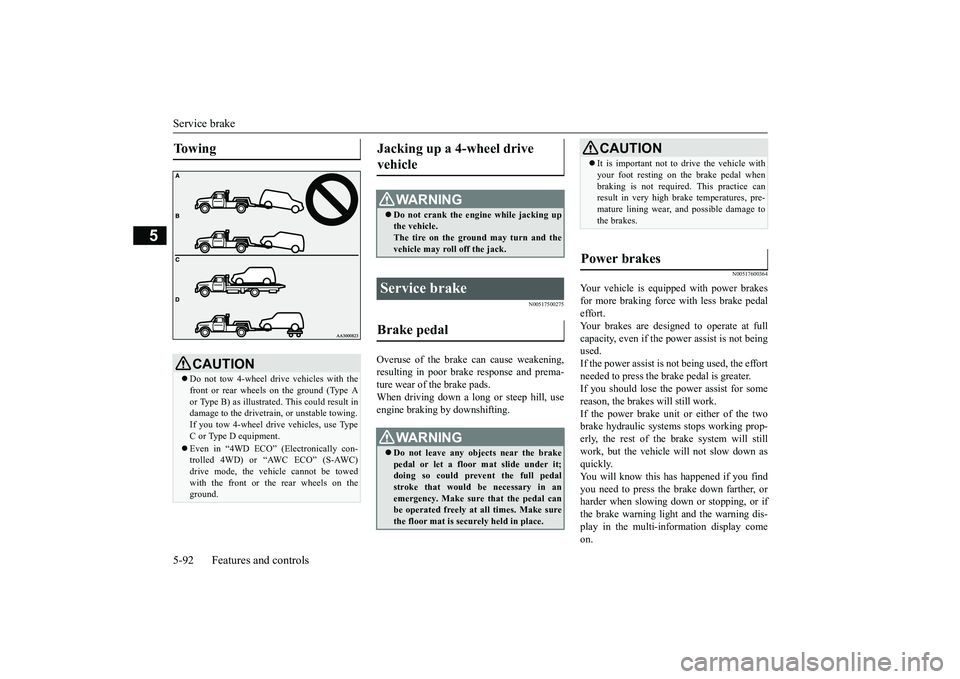
Service brake5-92 Features and controls
5
N00517500275
Overuse of the brake can cause weakening,resulting in poor brake response and prema-ture wear of the brake pads.When driving down a long or steep hill, useengine braking
by downshifting.
N00517600364
Your vehicle is equipped with power brakesfor more braking force with less brake pedaleffort.Your brakes are designed to operate at fullcapacity, even if the power assist is not beingused.If the power assist is not being used, the effortneeded to press the brake pedal is greater.If you should lose the power assist for somereason, the brakes will still work.If the power brake unit or either of the twobrake hydraulic systems stops working prop-erly, the rest of the brake system will stillwork, but the vehicle will not slow down asquickly.You will know this has happened if you findyou need to press the brake down farther, orharder when slowing down or stopping, or ifthe brake warning light and the warning dis-play in the multi-information display comeon.
To w i n g
CAUTIONDo not tow 4-wheel drive vehicles with thefront or rear wheels on the ground (Type Aor Type B) as illustrate
d. This could result in
damage to the drivetrain, or unstable towing.If you tow 4-wheel drive vehicles, use TypeC or Type D equipment.Even in “4WD ECO” (Electronically con-trolled 4WD) or “AWC ECO” (S-AWC)drive mode, the vehicle cannot be towedwith the front or the rear wheels on theground.
Jacking up a 4-wheel drive vehicle
WA R N I N GDo not crank the engine while jacking upthe vehicle.The tire on the ground may turn and thevehicle may roll off the jack.
Service brake Brake pedal
WA R N I N GDo not leave any objects near the brakepedal or let a floor mat slide under it;doing so could prevent the full pedalstroke that would be necessary in anemergency. Make sure that the pedal canbe operated freely at all times. Make surethe floor mat is securely held in place.
CAUTIONIt is important not to drive the vehicle withyour foot resting on the brake pedal whenbraking is not required.
This practice can
result in very high brake temperatures, pre-mature lining wear, a
nd possible damage to
the brakes.
Power brakes
BK0249100US.book 92 ページ 2017年5月10日 水曜日 午前8時49分
Page 337 of 441
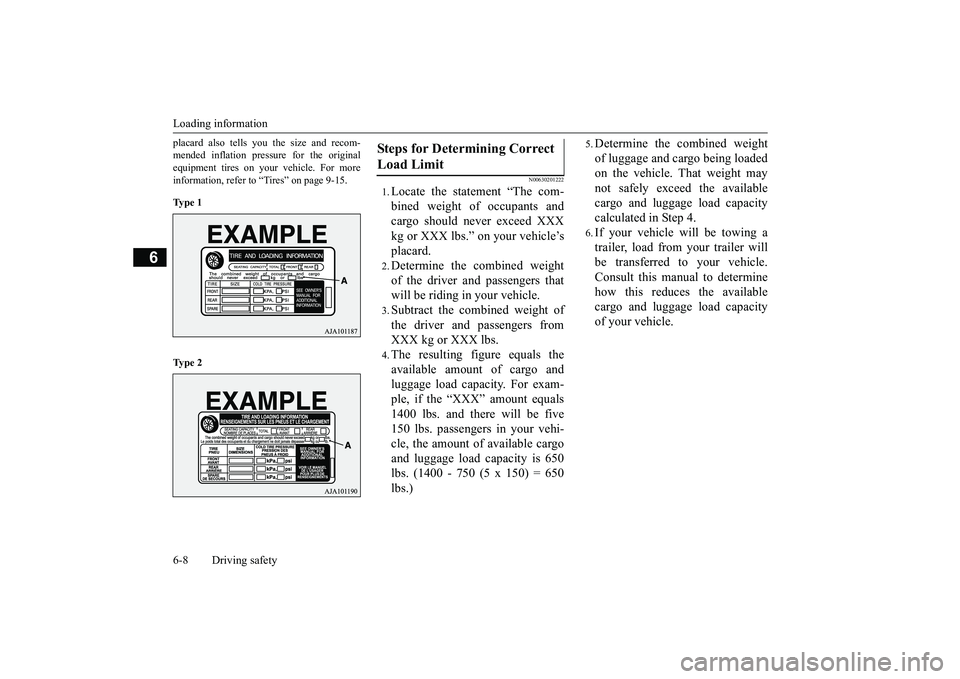
Loading information6-8 Driving safety
6
placard also tells you the size and recom-mended inflation pressure for the originalequipment tires on your vehicle. For moreinformation, refer to “Tires” on page 9-15.Ty p e 1Ty p e 2
N00630201222
1.Locate the statement “The com-bined weight of occupants andcargo should never exceed XXXkg or XXX lbs.” on your vehicle’splacard.2.Determine the combined weightof the driver and passengers thatwill be riding in your vehicle.3.Subtract the combined weight ofthe driver and passengers fromXXX kg or XXX lbs.4.The resulting figure equals theavailable amount of cargo andluggage load capacity. For exam-ple, if the “XXX” amount equals1400 lbs. and there will be five150 lbs. passengers in your vehi-cle, the amount of available cargoand luggage load
capacity is 650
lbs. (1400 - 750 (5 x 150) = 650lbs.)
5.Determine the combined weightof luggage and cargo being loadedon the vehicle. That weight maynot safely exceed the availablecargo and luggage load capacitycalculated in Step 4.6.If your vehicle will be towing atrailer, load from your trailer willbe transferred to your vehicle.Consult this manual to determinehow this reduces the availablecargo and luggage load capacityof your vehicle.
Steps for Determining Correct Load Limit
BK0249100US.book 8 ページ 2017年5月10日 水曜日 午前8時49分
Page 338 of 441
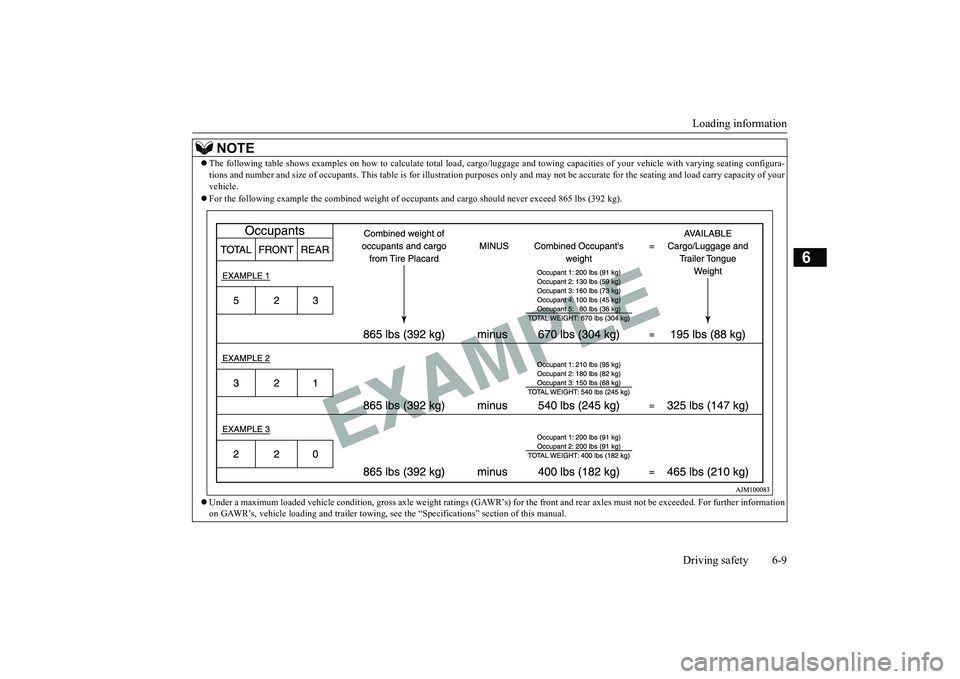
Loading informationDriving safety 6-9
6
NOTE
The following table shows examples on how to
calculate tota
l load, cargo/luggage and towing capa
cities of your vehicle with var
ying seating configura-
tions and number and size of occ
upants. This table is for illu
stration purposes only and may not
be accurate for the seating an
d load carry capacity of your
vehicle.For the following example the combined weight of oc
cupants and cargo should ne
ver exceed 865 lbs (392 kg).
Under a maximum loaded vehicle c
ondition, gross axle weight ratings (GAWR’s) for
the front and rear axles must not be exceeded.
For further information
on GAWR’s, vehicle loading and tr
ailer towing, see the “Specifica
tions” section of this manual.
BK0249100US.book 9 ページ 2017年5月10日 水曜日 午前8時49分
Page 341 of 441
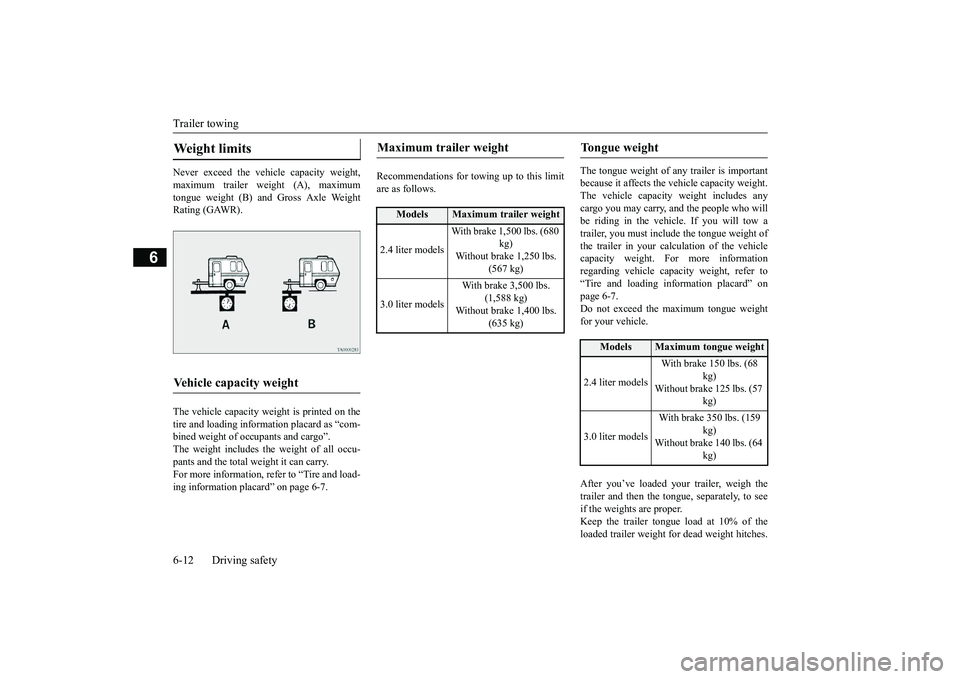
Trailer towing6-12 Driving safety
6
Never exceed the vehicle capacity weight,maximum trailer weight (A), maximumtongue weight (B) and Gross Axle WeightRating (GAWR).The vehicle capacity weight is printed on thetire and loading inform
ation placard as “com-
bined weight of oc
cupants and cargo”.
The weight includes the weight of all occu-pants and the total weight it can carry.For more information, refer to “Tire and load-ing information plac
ard” on page 6-7.
Recommendations for to
wing up to this limit
are as follows.
The tongue weight of a
ny trailer is important
because it affects the ve
hicle capacity weight.
The vehicle capacity weight includes anycargo you may carry, a
nd the people who will
be riding in the vehi
cle. If you will tow a
trailer, you must include the tongue weight ofthe trailer in your calculation of the vehiclecapacity weight. For more informationregarding vehicle capa
city weight, refer to
“Tire and loading information placard” onpage 6-7.Do not exceed the maximum tongue weightfor your vehicle.After you’ve loaded your trailer, weigh thetrailer and then the to
ngue, separately, to see
if the weights are proper.Keep the trailer tongue load at 10% of theloaded trailer weight fo
r dead weight hitches.
Weight limits Vehicle capacity weight
Maximum trailer weight
Models
Maximum trailer weight
2.4 liter models
With brake 1,500 lbs. (680
kg)
Without brake 1,250 lbs.
(567 kg)
3.0 liter models
With brake 3,500 lbs.
(1,588 kg)
Without brake 1,400 lbs.
(635 kg)
Tongue weight
Models
Maximum tongue weight
2.4 liter models
With brake 150 lbs. (68
kg)
Without brake 125 lbs. (57
kg)
3.0 liter models
With brake 350 lbs. (159
kg)
Without brake 140 lbs. (64
kg)
BK0249100US.book 12 ページ 2017年5月10日 水曜日 午前8時49分
Page 440 of 441
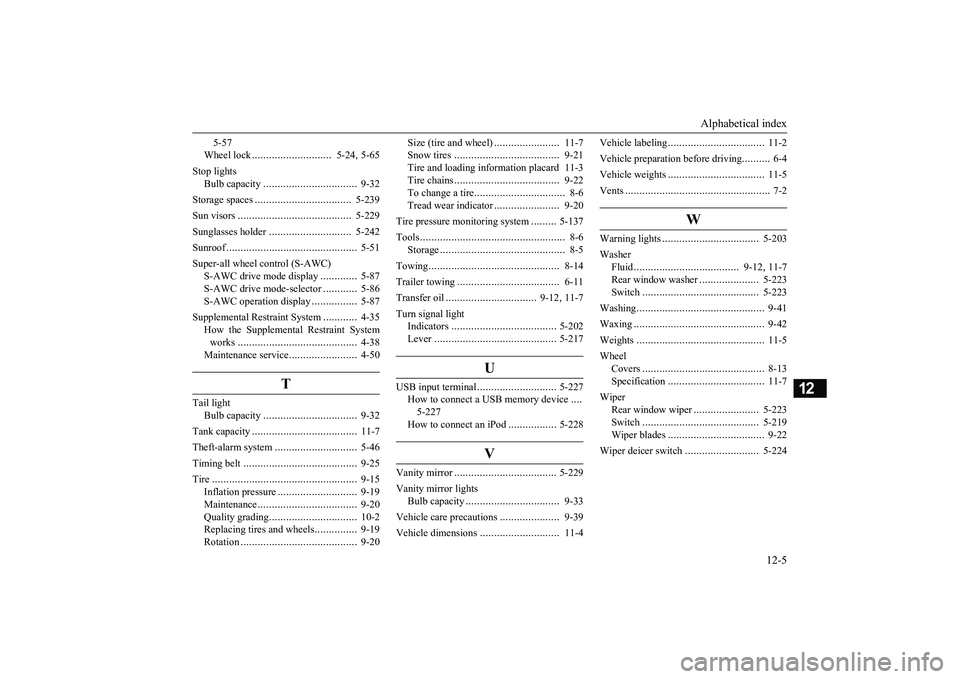
Alphabetical index
12-5
12
5-57Wheel lock
............................
5-24
, 5-65
Stop lights
Bulb capacity
.................................
9-32
Storage spaces
..................................
5-239
Sun visors
........................................
5-229
Sunglasses holder
.............................
5-242
Sunroof
..............................................
5-51
Super-all wheel control (S-AWC)
S-AWC drive mode display
.............
5-87
S-AWC drive mode-selector
............
5-86
S-AWC operation display
................
5-87
Supplemental Re
straint System
............
4-35
How the Supplemental Restraint Systemworks
..........................................
4-38
Maintenance service
........................
4-50
T
Tail light
Bulb capacity
.................................
9-32
Tank capacity
.....................................
11-7
Theft-alarm system
.............................
5-46
Timing belt
........................................
9-25
Tire
...................................................
9-15
Inflation pressure
............................
9-19
Maintenance
...................................
9-20
Quality grading
...............................
10-2
Replacing tires and wheels
...............
9-19
Rotation
.........................................
9-20
Size (tire and wheel)
.......................
11-7
Snow tires
.....................................
9-21
Tire and loading information placard 11-3Tire chains
.....................................
9-22
To change a tire
................................
8-6
Tread wear indicator
.......................
9-20
Tire pressure monitoring system
.........
5-137
Tools
...................................................
8-6
Storage
............................................
8-5
Towing
..............................................
8-14
Trailer towing
....................................
6-11
Transfer oil
................................
9-12
, 11-7
Turn signal light
Indicators
.....................................
5-202
Lever
...........................................
5-217
U
USB input terminal
............................
5-227
How to connect a USB memory device
....
5-227How to connect an iPod
.................
5-228
V
Vanity mirror
....................................
5-229
Vanity mirror lights
Bulb capacity
.................................
9-33
Vehicle care precautions
.....................
9-39
Vehicle dimensions
............................
11-4
Vehicle labeling
..................................
11-2
Vehicle preparation before driving
..........
6-4
Vehicle weights
..................................
11-5
Vents
...................................................
7-2
W
Warning lights
..................................
5-203
Washer
Fluid
.....................................
9-12
, 11-7
Rear window washer
.....................
5-223
Switch
.........................................
5-223
Washing
.............................................
9-41
Waxing
..............................................
9-42
Weights
.............................................
11-5
Wheel
Covers
...........................................
8-13
Specification
..................................
11-7
Wiper
Rear window wiper
.......................
5-223
Switch
.........................................
5-219
Wiper blades
..................................
9-22
Wiper deicer switch
..........................
5-224
BK0249100US.book 5 ページ 2017年5月10日 水曜日 午前8時49分